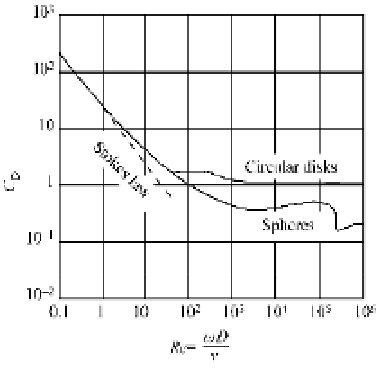Environmental Engineering Reference
In-Depth Information
In this range (
Re
p
> 10
3
), the fall velocity of a sphere is linearly proportional to the square root of its
diameter.
Fig. 5.21
Drag coefficient for settling of particles as a function of particle Reynolds number (Qian et al., 1998)
For particle Reynolds numbers between 0.4 and 10
3
, the corresponding
C
D
value is available from Fig. 5.21,
and by substituting it into Eq. (5.37), one obtains the fall velocity of a sphere with a given particle
diameter and the specific gravity of the given liquid (Rouse, 1946). For a quartz sphere with specific
gravity
J J
settling in water, the fall velocities at different temperatures are presented in Fig. 5.22.
Non-spherical particles can be regarded as a sphere because the particle settles with its surrounding liquid
behaving similar to a sphere. The fall velocity for most natural sand can be determined with Fig. 5.22
because the main minerals composing of natural sand are quartz and feldspar, the later has a similar density
and shape as the former.
s
/
. 5
Fig. 5.22
Fall velocity of a quartz sphere in clear water (Qian et al., 1998)
5.2.1.2
Buoyancy Force and Group Fall Velocity
For a group of particles falling in a liquid the buoyancy may be different from that for a single particle









Search WWH ::

Custom Search